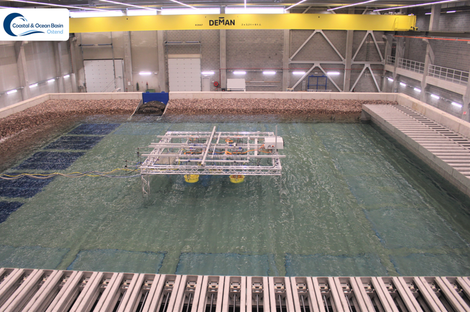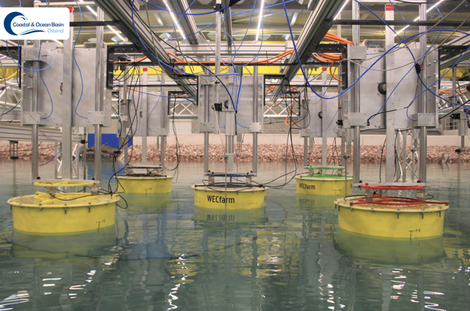WECfarm project tests
Background
Wave energy is a renewable form of energy which is largely untapped. Wave energy converters (WECs) are devices designed to harness this energy source and convert it to electricity. The last decades a considerable effort has been made by industry and academia to bring WECs to a commercial stage. There is a need for available real-life data to validate numerical models in the wave energy sector. However, publicly available databases from WEC array experiments are limited due to the high cost and complexity of conducting such experiments. The ‘WECfarm’ project, initiated by Ghent University, aims to improve the understanding of interactions between the individual WECs within an array, and address the need for experimental data on WEC array tests. A team from the Coastal Engineering Research Group of Ghent University performed experiments focused on the extraction of wave energy using an array of five point absorber WECs. Similar to offshore wind turbines, multiple point absorber WECs will be installed in an array configuration, to increase the total capacity, and to benefit from the economies of scale. Whereas wind turbines always interact destructively due to wake effects, WECs can interact constructively, since hydrodynamic interactions between the WECs occur through radiation and diffraction of waves, changing the direction of the incoming wave energy.
WECfarm WEC
The point-absorber ‘WECfarm’ WEC consists of a floating buoy to capture energy from waves coming from different directions. The WECs are equipped with a permanent magnet synchronous motor (PMSM), addressing the need for WEC array tests with an accurate and actively controllable Power Take-Off (PTO). The WEC array control and data acquisition are realized with a Speedgoat real-time target machine, offering the possibility to implement advanced WEC array control strategies in the MATLAB-Simulink environment. A configuration of three air bushings on each WEC is used for the linear guiding in the heave direction.
Objectives
As a result of the interaction between the WECs within the array, the overall power absorption is affected. Therefore, to maximize the power absorption, a control system tailored to the WEC array needs to be implemented. Control strategies aim to achieve resonance by altering the dynamics of the WEC system, as most power is produced during resonant absorption. The research team investigated how the WEC array layout should be optimized simultaneously with the applied control strategy to maximize the power absorption. System identification tests were executed to obtain an accurate dynamic model of the WEC array. Proportional (resistive) and Proportional-Integral (reactive) controllers were designed and tested accordingly. Finally, the wave height behind the WEC array is modified, which may influence neighboring arrays, other users in the sea or even the coastline, so-called wave mitigation effects. By the use of a layout of wave gauges, these mitigation effects are studied for various wave conditions.
Wave conditions
Various wave conditions were used within the project:
- Regular waves
- Irregular long-crested waves, operational and extreme conditions
- Irregular short-crested waves


This work was supported by the the FWO (Fonds Wetenschappelijk Onderzoek - Research Foundation Flanders), Belgium.
References:
- Vervaet, T., Stratigaki, V., De Backer, B., Stockman, K., Vantorre, M., & Troch, P. (2022). Experimental modelling of point-absorber wave energy converter arrays : a comprehensive review, identification of research gaps and design of the WECfarm setup. Journal of Marine Science and Engineering, 10(8). https://doi.org/10.3390/jmse10081062
- Vervaet, T. (2023). Experimental modelling of point absorber wave energy converter arrays with control design based on impedance matching. Ghent University. Faculty of Engineering and Architecture, Ghent, Belgium.